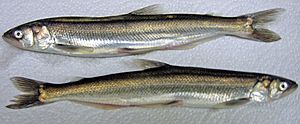Grease trail facts for kids
A grease trail was an old overland trade route. These trails were part of a big network connecting the Pacific coast with the Interior in the Pacific Northwest.
History of Grease Trails
These trails were first made for trading between Indigenous people. A very important item traded was eulachon oil, also called oolichan oil. This oil came from small fish. People traded the oil for things like furs, copper, and obsidian.
The Stó:lō people who lived near the Fraser River ate the eulachon fish fresh or smoked. But people living further inland used the oil like butter on their food and for many other things.
Why They Are Called Grease Trails
The name "Grease Trail" comes from the main item traded: the processed oil of the eulachon fish. This oil was so important that the Carrier language word for eulachon oil, /tl'inaɣe/, actually means "grease" or "oil."
For thousands of years, First Nations traders used these well-worn trails. They were usually the easiest paths across plateaus, highlands, and over tough mountains. Traders would carry heavy boxes of valuable eulachon oil on their backs. They used cedar ropes with headbands to help carry the load.
These trails worked like a relay system. They covered a huge area, from what is now the Yukon in Canada, south to northern California in the United States. They also went as far east as central Montana and Alberta. Many different Indigenous groups, like the Babine, Carrier, and other Athabaskans, used these trails.
Famous Grease Trails
Here are some well-known grease trails and former grease trails:
See also
 In Spanish: Ruta de la grasa para niños
In Spanish: Ruta de la grasa para niños


